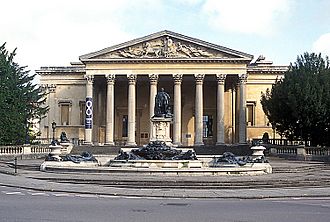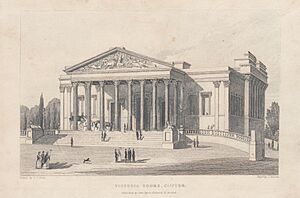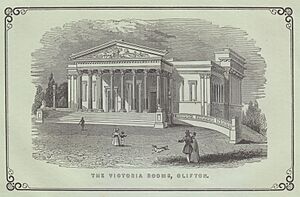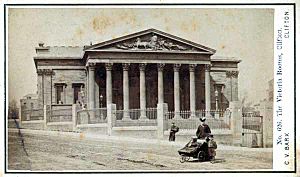Victoria Rooms, Bristol facts for kids
Quick facts for kids Victoria Rooms |
|
|---|---|

The Victoria Rooms now house the University of Bristol's Department of Music.
|
|
| General information | |
| Architectural style | Greek revival |
| Town or city | Bristol |
| Country | England |
| Coordinates | 51°27′29″N 2°36′33″W / 51.458°N 2.6091°W |
| Construction started | 1838 |
| Completed | 1842 |
| Cost | £23,000 |
| Design and construction | |
| Architect | Charles Dyer |
The Victoria Rooms, also known as the Vic Rooms, is a famous building in Clifton, Bristol, England. It is home to the University of Bristol's music department. This grand building sits at a busy spot where Queens Road and Whiteladies Road meet.
It was built between 1838 and 1842. The building was designed by Charles Dyer. It has a Greek revival style, which means it looks like ancient Greek temples. It was named after Queen Victoria, who became queen the year before it was started.
The front of the building has eight tall columns. Above the entrance, there is a detailed stone carving. A bronze statue of Edward VII was added in 1912. It stands in front of the building with a curved pool and fountains.
Inside, the Victoria Rooms has a large auditorium with 665 seats. It also has a lecture theatre, practice rooms, and a recording studio. Famous people like Jenny Lind (a singer) and Charles Dickens (a writer) performed here. The building also hosted important events. These included dinners for the opening of the Clifton Suspension Bridge. Meetings that led to the creation of the University College, Bristol also happened here. Even suffragettes, who fought for women's right to vote, held meetings here.
In 1920, the building was bought and given to the university. It was first used for the student union. After a fire in 1934, the building was repaired. The student union moved out in the 1960s. Since 1996, it has been home to the music department. Today, it is still used for concerts, plays, and lectures.
The Building's Design
The Victoria Rooms is located in Clifton, Bristol. It is at the meeting point of Queen's Road and Whiteladies Road. People often call it the Vic Rooms. Many people think it has one of the best locations in Clifton.
Charles Dyer designed the building as a place for public gatherings. The first stone was laid on May 24, 1838. This was Queen Victoria's 19th birthday. The building was named in her honor.
The building was finished in 1842. It was built in the Greek revival style. It has a large front porch with eight columns. These columns are about 30 feet (9 meters) tall. The building is made of cut stone, and its roof is made of slate. There are two sloping ramps outside. These ramps were built so carriages could drive right into the building.
Above the columns, there is a stone carving. It shows a goddess, thought to be Wisdom, in her chariot. She is bringing in the morning, followed by three goddesses called the Graces. This carving was made by Musgrave Watson.
A fire in 1934 caused a lot of damage. The main hall inside was rebuilt in 1935. An old description from 1838 said the inside design was not very special. But in 1849, it was described as having a Greek theme, matching the outside.
Inside the main entrance, there is a lobby. This leads to an octagonal room with a balcony and a domed ceiling. This room then leads to the main auditorium. In 1846, a special heating system was described. It used a cast iron stove to heat and move air. This kept the building much warmer inside than outside.
Most of the inside was changed in the mid-1900s. But some original plaster decorations are still there. A large organ was added to the main auditorium in 1873. This organ had been moved from other famous places. In 1899, it was decided to replace it with an electric organ. This new organ was destroyed in the 1934 fire.
Today, the building has a 665-seat auditorium. It also has rehearsal rooms for music. The auditorium is about 4,500 square feet (418 square meters). There is also a lecture theatre and a recital room. The building has special studios for creating and recording music. Other facilities include a bar, common rooms, and practice rooms.
The Front Area
The Victoria Rooms used to have iron fences around it. Old photos from the 1800s show these fences. They are no longer there. They might have been removed during the Second World War. This was part of a country-wide effort to collect metal for the war.
A statue of Edward VII was put in front of the building in 1912. It was designed by Edwin Alfred Rickards. The statue is part of a larger memorial. This includes a curved pool, lamps, steps, and fountains. The fountains have sculptures in the Art Nouveau style. Two sphinx statues that used to guard the building were moved for this new memorial.
The statue and fountains are considered very good examples of the artists' work. They are also listed as Grade II* buildings, meaning they are very important. A cool thing about the fountains is how they work. The water flow is controlled by a device that measures wind. On windy days, the water pressure is lowered. This stops the water from blowing onto the nearby road.
Building History
The foundation stone was laid on May 24, 1838. At the ceremony, the president, Thomas Daniel, spoke. He said the rooms were for "Conservative purposes." This meant they were for people to show loyalty to the Queen and support their country. Another speaker, P. F. Aiken, said the building would be admired by future generations. He believed public buildings show how civilized a place is.
The Victoria Rooms officially opened on May 24, 1842. Building started in 1838 and cost about £23,000. The money was raised by a group of "Conservative citizens."
Many famous artists performed here. These included the singer Jenny Lind and the writer Charles Dickens. Many private parties were also held at the rooms. These parties competed with others in Clifton.
The Victoria Rooms was also used for other events. In 1863, it hosted the first public show of electric lighting in Bristol. It held big dinners, too. One dinner celebrated the opening of the Clifton Suspension Bridge in 1864. Another celebrated 400 years since John Cabot explored North America in 1897.
On June 11, 1874, a meeting was held at the Victoria Rooms. This meeting was to create a science and literature college. This college became University College, Bristol. It was the first step towards the University of Bristol, which started in 1909. Important people attended this meeting, including Lord Kelvin. The meeting was successful. It gained support from the Fry family, famous for their chocolate business. In 1898, a big science conference was held at the rooms.
In the early 1900s, suffragettes used the Victoria Rooms. Annie Kenney and Clara Codd, who fought for women's right to vote, held meetings here. In 1920, a rich local businessman, Sir George Wills, bought the rooms. He gave them to the University to be the home of the students' union.
For a short time around 1924, the building was used as a cinema. The Victoria Rooms remained the student union's base until 1964. Then, a new building was built for them nearby. After that, the Victoria Rooms became a place for conferences and exhibitions. Bands like Pink Floyd even played concerts here in the 1960s. From 1987 to 1989, it housed a hands-on science center called the Exploratory.
In 1996, the University Music Department moved into the Victoria Rooms. Today, the building is still very active. It hosts many concerts, plays, lectures, and conferences. It serves a similar purpose now as it did when it was first built.
Images for kids








